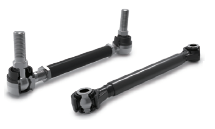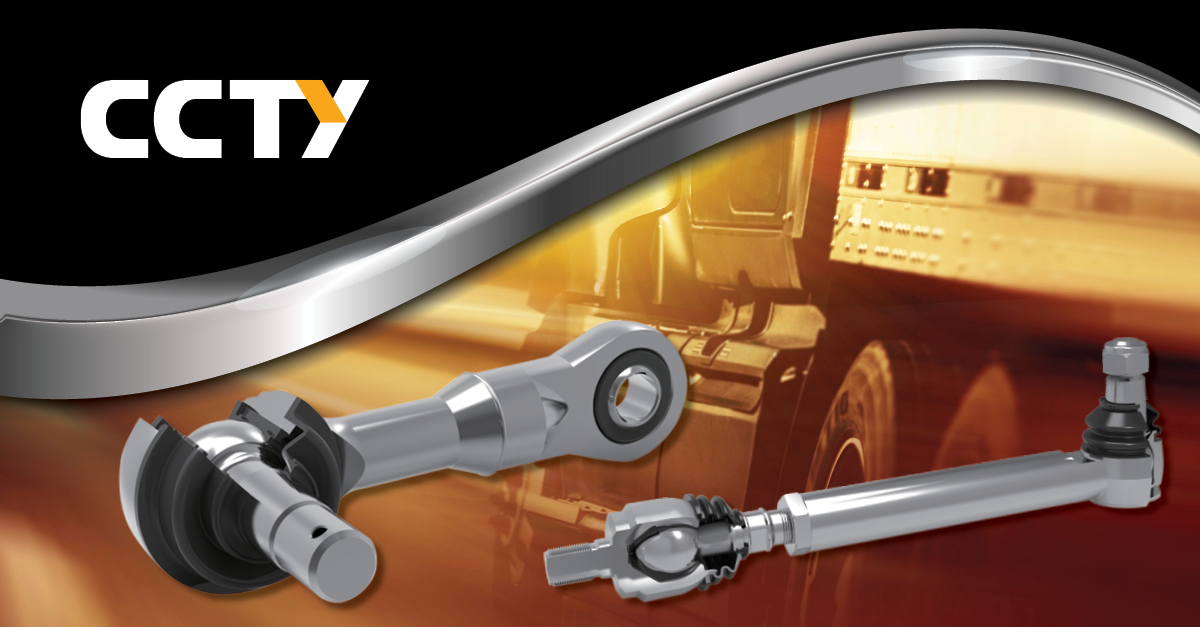- What is a Tie Rod?
- Designing Tie Rods
- Comparing Tie Rod Applications
- Why Steering Precision Depends on Tie Rod Stiffness
- Balancing Strength, Fatigue Life, and Durability
- Testing for Real-World Conditions
- Material Selection and Corrosion Resistance
- Advanced Engineering: Reducing Cost and Increasing Performance
- Customization and OEM Requirements
- Improving Tie Rod Durability Through Material Innovation
- Meeting the Demands of Modern Steering Systems
- Video: Design Priorities in Tie Rod Engineering
- Use Case: Forklift Tie Rod Reduces Cost & Improves Service Life
- Speak with a Tie Rod Expert
What is a Tie Rod?
Tie rods enable a vehicle’s wheels to turn in response to the steering wheel by pushing or pulling the wheel. Considered part of the steering system, they connect the steering rack to the knuckle on front wheels in cars. On heavy trucks, such as tractors and mining equipment, they are part of the axle.
Components on the inner and outer tie rod can include a combination of:
Tie Rod Design
These linkages are comprised of a metal sleeve with rod ends, ball joints or spherical plain bearings on either end. The ends are attached by welding, threading or crimping.
Referred to as inner and outer tie rods, the inner connects to a bearing housing and is covered by a seal to keep out containments. The outer tie rod is generally shorter than the inner and connects to the wheel assembly with a ball joint.
A steering tie rod is a critical component in vehicle control systems. It connects the steering rack to the knuckle, translating the rotational movement from the steering wheel into the motion that turns the tires. Beyond steering response, the tie rod plays a key role in setting and maintaining the toe angle, a factor essential for vehicle stability and tire wear.
Depending on the design, a steering tie rod may connect from the right to the left knuckle, while a drag link connects the steering rack to the tie rod itself. Together, they ensure precise steering geometry and alignment.
The Fundamentals of Tie Rod Design
When designing a tie rod, the first priority is safety. Engineers must calculate the ultimate push-out and pull-out loads of the ball stud, as well as its radial and fatigue loading. These values define the tie rod’s ability to withstand steering forces and cyclic motion without failure.
Once the load requirements are defined, attention shifts to joint design, specifically, the interaction between the ball and its race (metal or polymer) and how the joint seals under all angles of operation. After confirming structural integrity, engineers then consider secondary factors like corrosion resistance and appearance to meet OEM specifications.
Comparing Tie Rod Applications: Off-Highway vs. Industrial
Different vehicles place different demands on tie rod performance.
Off-highway and side-by-side vehicles require high articulation to accommodate large suspension travel. Their joints must allow significant sliding within the housing without excessive wear, and the boot seals must flex at extreme angles while keeping out mud and debris.
Forklift, agricultural, and industrial tie rods, on the other hand, tend to be heavier, bulkier, and designed with higher safety factors. Weight is less critical than strength and serviceability — these components must be easy to maintain, replace, or rebuild in the field.
In both cases, seal design is vital. For off-highway vehicles that may be submerged in mud, sealing performance determines whether the joint remains reliable or fails prematurely.
Why Steering Precision Depends on Tie Rod Stiffness
The stiffness of the steering tie rod directly influences steering feedback. A stiffer connection between the steering wheel and tires provides better road feel and control. Conversely, a loose or worn joint reduces feedback, increases steering play, and makes it harder for the driver to keep the vehicle on course.
To minimize play, engineers preload the joint during assembly, whether through mechanical shims in metal-to-metal joints or controlled compression in polymer-based designs. This ensures that the tie rod operates smoothly from day one and maintains tight tolerances throughout its life.
Balancing Strength, Fatigue Life, and Durability
Ultimate and fatigue load validation are central to tie rod engineering. These are the first elements verified through lab testing to ensure the part meets safety requirements. However, real-world durability often comes down to one factor: sealing.
Seals face extreme challenges – temperature swings, humidity, ozone, salt, and debris. The most common failure mode for tie rods isn’t mechanical breakage, but seal deterioration. Once contaminants enter the joint, they degrade grease, create excess play, and accelerate wear.
The driver may then feel backlash in the steering wheel or reduced responsiveness, clear signs of joint contamination.
Testing for Real-World Conditions
Field testing remains the gold standard for tie rod validation, but extensive lab testing supports product development. Engineers conduct:
- Fatigue testing on studs and connection rods.
- Seal testing under extreme temperature, humidity, and salt or mud spray exposure.
- Puncture resistance checks to ensure the boot withstands debris impact.
- Ozone and material degradation testing for long-term reliability.
Each test ensures that the tie rod’s components can survive the harsh environments found in construction, agricultural, and on-road applications.
Material Selection and Corrosion Resistance
Materials and coatings are crucial for achieving long-lasting tie rod assemblies. Ball studs are typically made from chrome-moly or alloy steels that offer excellent heat treatability and toughness, necessary for high fatigue life. Housings often use similar materials, though in some cases carbon steel may suffice when high fatigue resistance is less critical.
To combat corrosion, common coatings include zinc, zinc-nickel, e-coat, and powder coatings. The choice depends on the customer’s requirements for appearance and protection. For fully sealed joints, corrosion-resistant coatings can sometimes be reduced or eliminated to save cost without sacrificing performance.
Advanced Engineering: Reducing Cost and Increasing Performance
Modern tie rod design optimization often involves reducing unnecessary machining. For forged housings and connection rods, engineers aim to minimize machined surfaces without compromising fit or strength.
Finite Element Analysis (FEA) is used to ensure material is only applied where necessary, avoiding excess weight and cost. Inside the joint, material selection also impacts cost and performance, lower-cost polymers may be used when appropriate, provided they meet load and wear criteria.
Internal geometry is refined to reduce wear, improve torque consistency, and extend service life.
Customization and OEM Requirements
Every steering tie rod is customized to meet an OEM’s unique requirements. Differences in steering geometry, load targets, vehicle weight, and articulation angles all influence design. Engineers adjust:
Improving Tie Rod Durability Through Material Innovation
Meeting the Demands of Modern Steering Systems
Tie Rod Frequently Asked Questions
Can a vehicle be driven with a broken or worn tie rod?
What are symptoms of faulty tie rods?
- A short shrieking sound, knocking or a clunky noise
- More slack in the steering wheel or vague turning capabilities
- The vehicle pulling to one side
- Shaky front wheels
- Misaligned tires
- Excessively worn tires
What causes tie rod failure?
- An impact that breaks or bends the shaft or ball joint
- Ball joints that have allowed dust or water to enter due to cracked boot seals
- Improper maintenance if ball joints require greasing and are not addressed per schedule
- Broken or cracked dust boot that allows water and other corrosive substances into the joint
- Standard wear and tear
What materials are used to make a tie rod?
Steel is one of the most important elements when making a tie rod. Quality steel means the difference between a long lasting linkage and one that succumbs to the pressures under a load.
The material used on inner and outer tie rod components is also important. Tie rods are shipped as an assembly, so it is important to work with a manufacturer who can accurately manufacture and assemble the entire tie rod to your specifications.
What questions should OEMs ask manufacturers about tie rod steel?
- Where do you buy your steel?
- Knowing the steel source is important since the standard chemical composition of chromium can vary.
- Steel from North America or Europe is considered to be among the best quality. If it is not from these regions, how does the manufacturer determine the melt source to be equal in quality?
- What kind of testing do they do to the steel?
- How can you prove that each batch meets standards? And is the steel measured against a recognized international standard or an internal standard?
- How is the steel treated?
- Strict specifications on oxygen, inclusion and carbide distribution
- Heat treatment to increase material impact load capacity
- Adding diffusion normalizing heat treatment
- Can you trace back an end product to the steel lot?
- A tie rod manufacturer who can trace the final product back to a specific steel lot, which was tested for adherence to the manufacturer’s standards, is vital for risk management.
- The ability to trace a product throughout the manufacturing process also indicates that the manufacturer takes customer specifications and internal production requirements seriously.
Tie Rod Design Priorities


